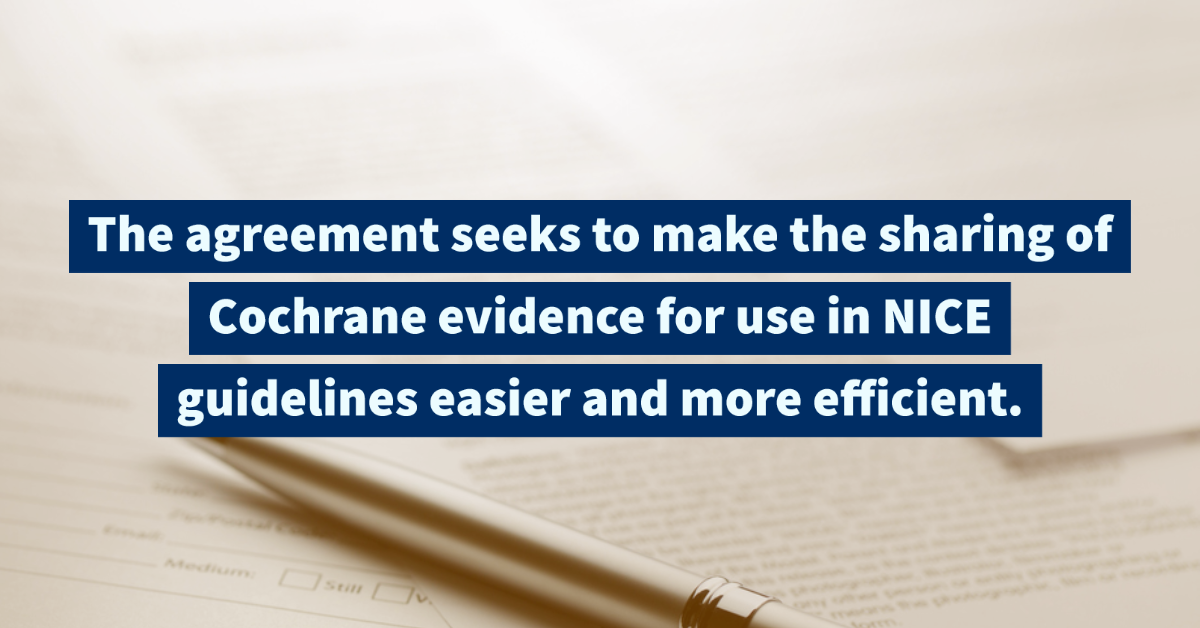
Cochrane are signing a collaboration licence agreement with NICE, the National Institute for Health and Care Excellence, the UK government’s guideline organization. Cochrane has a long-established relationship with the NHS and the National Institute for Health research (NIHR), and Cochrane Reviews are already used to inform NICE guidelines. The agreement seeks to make this sharing of Cochrane evidence for use in NICE guidelines easier and more efficient.
Toby Lasserson, Cochrane’s Deputy Editor in Chief, and Gill Leng, Chief Executive Officer, NICE, sat down with us to explain more about the agreement and its impact.

Can you tell us about the collaboration agreement between Cochrane and NICE?
Gill: The agreement between Cochrane and NICE is a collaborative one which will allow both organisations to share the latest evidence more quickly and efficiently. The agreement will help NICE specifically in achieving faster and more flexible ways of working when it comes to developing our guideline recommendations by using high quality, relevant Cochrane systematic reviews. Cochranes systematic reviews have a well-established reputation for producing high quality reviews of evidence. NICE will be able to utilise those reviews to ensure we are making new recommendations or updating existing recommendations more quickly when new evidence comes to light.
Toby: Over the last few years Cochrane Review Groups have been approached by NICE guideline committees with a view to prioritising and producing reviews to support the guideline process. This has led to some high priority Cochrane Reviews being used in guidelines for lung disease and preventing falls. It can be hard to coordinate timely production of reviews with the guideline development process. Sharing results of reviews before publication in the Cochrane Library has helped to reduce some of the time pressure.
For Cochrane there’s been understandable concern about sharing unpublished reviews because they have not been subject to complete editorial and peer review processes. However, it’s important to remember that most guideline committees are used to drawing on systematic reviews that have not yet been peer reviewed or formally published. They also tend to focus on results and GRADE tables, whereas Cochrane will see these as constituent parts of the published review. We should acknowledge that the licence is only a mechanism that outlines the terms of sharing results from reviews in advance of publication. There is a lot to be gained from effective dialogue and engagement between guideline developers and review teams as early as possible.
What does this mean, in practice, for sharing evidence between the two organisations? Why is it important?
Gill: Sharing evidence is going to add a much more flexible and efficient way of working for NICE. The world of healthcare is changing at a rapid pace, and we all need to respond and move with it. Advancements in healthcare and innovative practices really are coming thick and fast, and by working together to share the evidence we have built up, NICE and Cochrane can maintain robust procedures to assess clinical and cost-effectiveness while keeping up with the pace of change around us. That is something we know is expected of us on a political level, but more important than that, the people working within and who use our health services expect us to do that.

Toby: It means that there is a formal process for people preparing reviews for publication in the Cochrane Library to share their findings with NICE guideline developers ahead of publication. We needed an agreement that did not change the terms of the licence for publication that Cochrane author teams sign when they publish with us. There were plenty of technical discussions between us, but thanks to Christie Redley and Beth Collins in the contracts team in Cochrane and Ian Moir at NICE we’ve got the balance of rights in place.
It’s important to recognise that the licence does not change some hard-edged difficulties that delivering reviews to inform guideline development can bring. People involved in the preparation of these reviews will not always be funded directly to do this, and, as we saw last year there is always a balance between rigour and speed. There’s a widespread recognition that there is not always a good alignment between questions of interest to guideline developers with those of Cochrane Reviews. The commissioning brief might necessitate the collection of data for other outcomes than those prespecified, and that can be hard to work into the review that’s already been developed to a published protocol.
Establishing engagement between guideline development teams and review teams is an important part of identifying what’s feasible. In that regard the licence is less important than the principle of collaborative working.
What will the impact of this agreement be for putting Cochrane evidence into practice via NICE guidelines?
Toby: Actively supporting the process of delivering reviews for NICE guidelines in this way means that we can get the findings of our reviews in to the process of developing practice recommendations for the NHS. This ensures we are better placed to inform decisions through the guidance of a respected public body.
Sharing evidence with NICE is part of a broader approach to help Cochrane to identify priority reviews, and to identify them early. Some of the key decisions around initiating updates of Cochrane Reviews are about the question that they address. This will inevitably mean carefully re-evaluating the population, intervention, comparison and outcomes in our reviews. Whilst review questions change over time, delivering reviews that our stakeholders need from us will always be a fundamental good we can offer.
Who will benefit from this agreement?
Gill: By using the expertise we have at both NICE and Cochrane, we will ultimately be able to provide recommendations which react to and utilise the very latest scientific evidence. That’s going to have a tangible impact for clinicians working on the front line in the health service as they will be able to access NICE guidelines faster which will ultimately lead to better health outcomes for those who need it most.
Toby: This helps NICE, Cochrane Review Groups and authors. NICE will get the findings of a Cochrane Review to use in their deliberations, Cochrane groups will be able to demonstrate responsiveness in supporting production of high priority reviews, and for authors it guarantees impact. The ultimate beneficiaries will be people who need evidence to make decisions about their health or that of someone else.

What other work is being done to align research priorities between Cochrane and NICE? How has the pandemic affected this work?
Gill: The COVID-19 pandemic has made the last 15 months incredibly difficult for everyone working in the health service. However, one of the things we all need to take away from this period is the way organisations have built on existing collaborative and effective working relationships to deliver the best outcomes for patients despite the pandemic. NICE and Cochrane have been no different, and the work we have done together before and during the pandemic can now be built on by this agreement and help inform NICE’s recommendations across our guideline portfolio.
NICE is currently prioritising its large guideline portfolio (over 300 guidelines with 20,000 recommendations) to ensure that it focuses on areas where it is best placed to use our skills to add value.This means that we will be prioritising specific areas from within guidelines for surveillance and updating activity.
Following prioritisation of the NICE Guideline portfolio, NICE has committed to working with Cochrane, the UK Cochrane Centre and individual Cochrane Review Groups to identify relevant reviews that may inform the surveillance, development or update of high priority guideline recommendations. Dedicated technical resource will be recruited by NICE to work with Cochrane to develop and implement processes for aligning where feasible, reviewing and guideline development activities to ensure efficient, sustainable processes going forward.
Our experience from developing and maintaining rapid reviews and guidelines in response to the COVID pandemic has revealed how resource intensive a living approach to evidence reviewing and guideline development can be. The pandemic also emphasised the importance of collaborative approaches to ensuring scalability and sustainability of living approaches and the NICE Cochrane collaborative agreement is an important step toward realising this vision.
How will the partnership between Cochrane and NICE advance each organisation’s strategic goals?
Gill: In March 2021, NICE published our new 5-year strategy. One of the main commitments within the new direction was to provide dynamic, living guideline recommendations that are useful, useable and rapidly updated. Those guidelines will incorporate the latest evidence and newly recommended technologies to maximise uptake and access for patients. Cochrane has a well-established reputation for providing high quality systematic reviews of the latest evidence, and already works closely with the NHS, so a formal partnership which gives NICE access to the expertise that Cochrane has really made sense. That’s not just so we can tick a box and say we’re delivering on our strategic goals though; it’s going to have a real benefits for a wide range of stakeholders.
Toby: Cochrane has always recognised the importance of the evidence it produces for guideline development, and our reviews are flagged in this way on the Cochrane Library. It also means that we know we are producing high priority reviews for stakeholders.
Cochrane’s vision is a world of better health transformed by evidence. Knowing what questions are most important to end users of our evidence helps us to achieve that.

